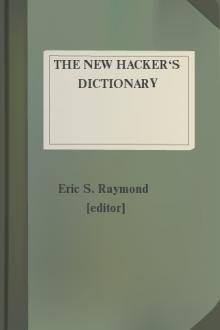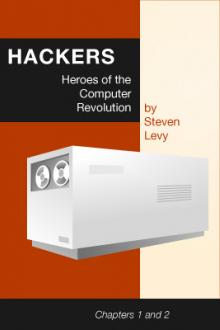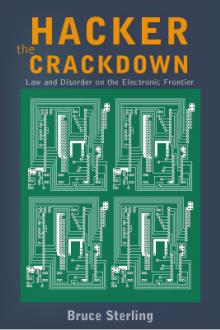The Jargon File by Eric S. Raymond (ebook reader android txt) 📕

- Author: Eric S. Raymond
- Performer: -
Book online «The Jargon File by Eric S. Raymond (ebook reader android txt) 📕». Author Eric S. Raymond
[3771]off the trolley. Esp. used of programs that just sit there
silently grinding long after either failure or some output is
expected. "Uh oh. I should have gotten a prompt ten seconds ago. The
program's in deep space somewhere." Compare [3772]buzz,
[3773]catatonic, [3774]hyperspace. 2. The metaphorical location of a
human so dazed and/or confused or caught up in some esoteric form of
[3775]bogosity that he or she no longer responds coherently to normal
communication. Compare [3776]page out.
Node:defenestration, Next:[3777]defined as, Previous:[3778]deep space,
Up:[3779]= D =
defenestration n.
[mythically from a traditional Czech assasination method, via SF
fandom] 1. Proper karmic retribution for an incorrigible punster. "Oh,
ghod, that was awful!" "Quick! Defenestrate him!" 2. The act of
exiting a window system in order to get better response time from a
full-screen program. This comes from the dictionary meaning of
`defenestrate', which is to throw something out a window. 3. The act
of discarding something under the assumption that it will improve
matters. "I don't have any disk space left." "Well, why don't you
defenestrate that 100 megs worth of old core dumps?" 4. Under a GUI,
the act of dragging something out of a window (onto the screen).
"Next, defenestrate the MugWump icon." 5. The act of completely
removing Micro$oft Windows from a PC in favor of a better OS
(typically Linux).
Node:defined as, Next:[3780]dehose, Previous:[3781]defenestration,
Up:[3782]= D =
defined as adj.
In the role of, usually in an organization-chart sense. "Pete is
currently defined as bug prioritizer." Compare [3783]logical.
Node:dehose, Next:[3784]deletia, Previous:[3785]defined as, Up:[3786]=
D =
dehose /dee-hohz/ vt.
To clear a [3787]hosed condition.
Node:deletia, Next:[3788]deliminator, Previous:[3789]dehose,
Up:[3790]= D =
deletia n. /d*-lee'sha/
[USENET; common] In an email reply, material omitted from the quote of
the original. Usually written rather than spoken; often appears as a
pseudo-tag or ellipsis in the body of the reply, as "[deletia]" or
"".
Node:deliminator, Next:[3791]delint, Previous:[3792]deletia,
Up:[3793]= D =
deliminator /de-lim'-in-ay-t*r/ n.
[portmanteau, delimiter + eliminate] A string or pattern used to
delimit text into fields, but which is itself eliminated from the
resulting list of fields. This jargon seems to have originated among
Perl hackers in connection with the Perl split() function; however, it
has been sighted in live use among Java and even Visual Basic
programmers.
Node:delint, Next:[3794]delta, Previous:[3795]deliminator, Up:[3796]=
D =
delint /dee-lint/ v. obs.
To modify code to remove problems detected when [3797]linting.
Confusingly, this process is also referred to as `linting' code. This
term is no longer in general use because ANSI C compilers typically
issue compile-time warnings almost as detailed as lint warnings.
Node:delta, Next:[3798]demented, Previous:[3799]delint, Up:[3800]= D =
delta n.
[techspeak] A quantitative change, especially a small orincremental one (this use is general in physics and engineering). "I
just doubled the speed of my program!" "What was the delta on program
size?" "About 30 percent." (He doubled the speed of his program, but
increased its size by only 30 percent.) 2. [Unix] A [3801]diff,
especially a [3802]diff stored under the set of version-control tools
called SCCS (Source Code Control System) or RCS (Revision Control
System). 3. n. A small quantity, but not as small as [3803]epsilon.
The jargon usage of [3804]delta and [3805]epsilon stems from the
traditional use of these letters in mathematics for very small
numerical quantities, particularly in `epsilon-delta' proofs in limit
theory (as in the differential calculus). The term [3806]delta is
often used, once [3807]epsilon has been mentioned, to mean a quantity
that is slightly bigger than [3808]epsilon but still very small. "The
cost isn't epsilon, but it's delta" means that the cost isn't totally
negligible, but it is nevertheless very small. Common constructions
include within delta of --',within epsilon of --': that is, `close
to' and `even closer to'.
Node:demented, Next:[3809]demigod, Previous:[3810]delta, Up:[3811]= D
=
demented adj.
Yet another term of disgust used to describe a malfunctioning program.
The connotation in this case is that the program works as designed,
but the design is bad. Said, for example, of a program that generates
large numbers of meaningless error messages, implying that it is on
the brink of imminent collapse. Compare [3812]wonky,
[3813]brain-damaged, [3814]bozotic.
Node:demigod, Next:[3815]demo, Previous:[3816]demented, Up:[3817]= D =
demigod n.
A hacker with years of experience, a world-wide reputation, and a
major role in the development of at least one design, tool, or game
used by or known to more than half of the hacker community. To qualify
as a genuine demigod, the person must recognizably identify with the
hacker community and have helped shape it. Major demigods include Ken
Thompson and Dennis Ritchie (co-inventors of [3818]Unix and [3819]C),
Richard M. Stallman (inventor of [3820]EMACS), Larry Wall (inventor of
[3821]Perl), Linus Torvalds (inventor of [3822]Linux), and most
recently James Gosling (inventor of Java, [3823]NeWS, and
[3824]GOSMACS) and Guido van Rossum (inventor of [3825]Python). In
their hearts of hearts, most hackers dream of someday becoming
demigods themselves, and more than one major software project has been
driven to completion by the author's veiled hopes of apotheosis. See
also [3826]net.god, [3827]true-hacker.
Node:demo, Next:[3828]demo mode, Previous:[3829]demigod, Up:[3830]= D
=
demo /de'moh/
[short for `demonstration'] 1. v. To demonstrate a product or
prototype. A far more effective way of inducing bugs to manifest than
any number of [3831]test runs, especially when important people are
watching. 2. n. The act of demoing. "I've gotta give a demo of the
drool-proof interface; how does it work again?" 3. n. Esp. as `demo
version', can refer either to an early, barely-functional version of a
program which can be used for demonstration purposes as long as the
operator uses exactly the right commands and skirts its numerous bugs,
deficiencies, and unimplemented portions, or to a special version of a
program (frequently with some features crippled) which is distributed
at little or no cost to the user for enticement purposes. 4.
[[3832]demoscene] A sequence of [3833]demoeffects (usually) combined
with self-composed music and hand-drawn ("pixelated") graphics. These
days (1997) usually built to attend a [3834]compo. Often called
`eurodemos' outside Europe, as most of the [3835]demoscene activity
seems to have gathered in northern Europe and especially Scandinavia.
See also [3836]intro, [3837]dentro.
Node:demo mode, Next:[3838]demoeffect, Previous:[3839]demo, Up:[3840]=
D =
demo mode n.
[Sun] The state of being [3841]heads down in order to finish codein time for a [3842]demo, usually due yesterday. 2. A mode in which
video games sit by themselves running through a portion of the game,
also known as `attract mode'. Some serious [3843]apps have a demo mode
they use as a screen saver, or may go through a demo mode on startup
(for example, the Microsoft Windows opening screen -- which lets you
impress your neighbors without actually having to put up with
[3844]Microsloth Windows).
Node:demoeffect, Next:[3845]demogroup, Previous:[3846]demo mode,
Up:[3847]= D =
demoeffect n.
[[3848]demoscene] What among hackers is called a [3849]display hack.
Classical effects include "plasma" (colorful mess), "keftales"
(xx+yy and other similar patterns, usually combined with
color-cycling), realtime fractals, realtime 3d graphics, etc.
Historically, demo effects have cheated as much as possible to gain
more speed and more complexity, using low-precision math and masses of
assembler code and building animation realtime are three common
tricks, but use of special hardware to fake effects is a [3850]Good
Thing on the demoscene (though this is becoming less common as
platforms like the Amiga fade away).
Node:demogroup, Next:[3851]demon, Previous:[3852]demoeffect,
Up:[3853]= D =
demogroup n.
[[3854]demoscene] A group of [3855]demo (sense 4) composers. Job
titles within a group include coders (the ones who write programs),
graphicians (the ones who painstakingly pixelate the fine art),
musicians (the music composers), [3856]sysops, traders/swappers (the
ones who do the trading and other PR), and organizers (in larger
groups). It is not uncommon for one person to do multiple jobs, but it
has been observed that good coders are rarely good composers and vice
versa. [How odd. Musical talent seems common among Internet/Unix
hackers --ESR]
Node:demon, Next:[3857]demon dialer, Previous:[3858]demogroup,
Up:[3859]= D =
demon n.
[MIT] A portion of a program that is not invoked explicitly, butthat lies dormant waiting for some condition(s) to occur. See
[3860]daemon. The distinction is that demons are usually processes
within a program, while daemons are usually programs running on an
operating system. 2. [outside MIT] Often used equivalently to
[3861]daemon -- especially in the [3862]Unix world, where the latter
spelling and pronunciation is considered mildly archaic.
Demons in sense 1 are particularly common in AI programs. For example,
a knowledge-manipulation program might implement inference rules as
demons. Whenever a new piece of knowledge was added, various demons
would activate (which demons depends on the particular piece of data)
and would create additional pieces of knowledge by applying their
respective inference rules to the original piece. These new pieces
could in turn activate more demons as the inferences filtered down
through chains of logic. Meanwhile, the main program could continue
with whatever its primary task was.
Node:demon dialer, Next:[3863]demoparty, Previous:[3864]demon,
Up:[3865]= D =
demon dialer n.
A program which repeatedly calls the same telephone number. Demon
dialing may be benign (as when a number of communications programs
contend for legitimate access to a [3866]BBS line) or malign (that is,
used as a prank or denial-of-service attack). This term dates from the
[3867]blue box days of the 1970s and early 1980s and is now
semi-obsolescent among [3868]phreakers; see [3869]war dialer for its
contemporary progeny.
Node:demoparty, Next:[3870]demoscene, Previous:[3871]demon dialer,
Up:[3872]= D =
demoparty n.
[[3873]demoscene] Aboveground descendant of the [3874]copyparty, with
emphasis shifted away from software piracy and towards [3875]compos.
Smaller demoparties, for 100 persons or less, are held quite often,
sometimes even once a month, and usually last for one to two days. On
the other end of the scale, huge demo parties are held once a year
(and four of these have grown very large and occur annually - Assembly
in Finland, The Party in Denmark, The Gathering in Norway, and NAID
somewhere in north America). These parties usually last for three to
five days, have room for 3000-5000 people, and have a party network
with connection to the internet.
Node:demoscene, Next:[3876]dentro, Previous:[3877]demoparty,
Up:[3878]= D =
demoscene /dem'oh-seen/
[also `demo scene'] A culture of multimedia hackers located primarily
in Scandinavia and northern Europe. Demoscene folklore recounts that
when old-time [3879]warez d00dz cracked some piece of software they
often added an advertisement of in the beginning, usually containing
colorful [3880]display hacks with greetings to other cracking groups.
The demoscene was born among people who decided building these display
hacks is more interesting than hacking and began to build
self-contained display hacks of considerable elaboration and beauty
(within the culture such a hack is called a [3881]demo). The split
seems to have happened at the end of the 1980s. As more of these
[3882]demogroups emerged, they started to have [3883]compos at copying
parties (see [3884]copyparty), which later evolved to standalone
events (see [3885]demoparty). The demoscene has retained some traits
from the [3886]warez d00dz, including their style of handles and group
names and some of their jargon.
Traditionally demos were written in assembly language, with lots of
smart tricks, self-modifying code, undocumented op-codes and the like.
Some time around 1995, people started coding demos in C, and a couple
of years after that, they also started using Java.
Ten years on (in 1998-1999), the demoscene is changing as its original
platforms (C64, Amiga, Spectrum, Atari ST, IBM PC under DOS) die out
and activity shifts towards Windows, Linux, and the Internet. While
deeply underground in the past, demoscene is trying to get into the
mainstream as accepted art form, and one symptom of this is the
commercialization of bigger demoparties. Older demosceneers frown at
this, but the majority think it's a good direction. Many demosceneers
end up working in the computer game industry. Demoscene resource pages
are available at [3887]http://www.oldskool.org/demos/explained/ and
[3888]http://www.scene.org/.
Node:dentro, Next:[3889]depeditate, Previous:[3890]demoscene,
Up:[3891]= D =
dentro /den'troh/
[[3892]demoscene] Combination of [3893]demo (sense 4) and [3894]intro.
Other name mixings include intmo, dentmo etc.





Comments (0)